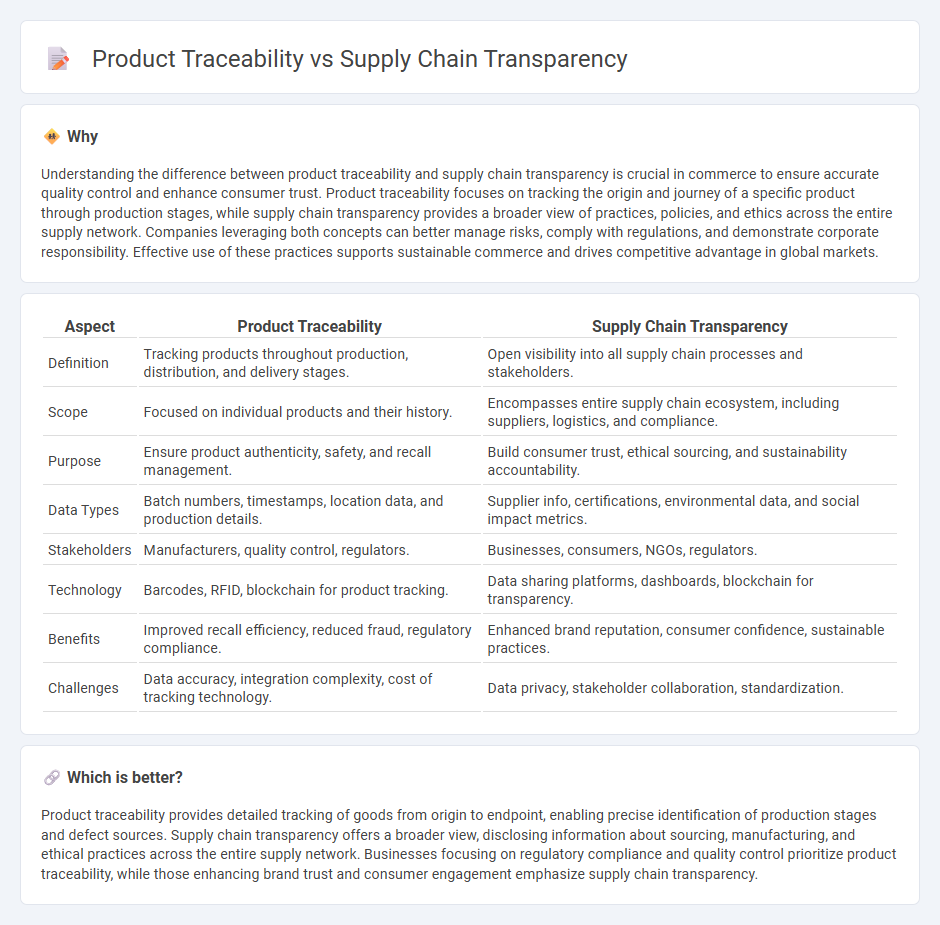
Product traceability ensures precise tracking of goods from origin to final destination, enabling quick identification of defects and recalls. Supply chain transparency provides a broader view of all processes, stakeholders, and ethical practices involved in the entire supply chain. Explore the differences and benefits to enhance your commerce strategy.
Why it is important
Understanding the difference between product traceability and supply chain transparency is crucial in commerce to ensure accurate quality control and enhance consumer trust. Product traceability focuses on tracking the origin and journey of a specific product through production stages, while supply chain transparency provides a broader view of practices, policies, and ethics across the entire supply network. Companies leveraging both concepts can better manage risks, comply with regulations, and demonstrate corporate responsibility. Effective use of these practices supports sustainable commerce and drives competitive advantage in global markets.
Comparison Table
| Aspect | Product Traceability | Supply Chain Transparency |
|---|---|---|
| Definition | Tracking products throughout production, distribution, and delivery stages. | Open visibility into all supply chain processes and stakeholders. |
| Scope | Focused on individual products and their history. | Encompasses entire supply chain ecosystem, including suppliers, logistics, and compliance. |
| Purpose | Ensure product authenticity, safety, and recall management. | Build consumer trust, ethical sourcing, and sustainability accountability. |
| Data Types | Batch numbers, timestamps, location data, and production details. | Supplier info, certifications, environmental data, and social impact metrics. |
| Stakeholders | Manufacturers, quality control, regulators. | Businesses, consumers, NGOs, regulators. |
| Technology | Barcodes, RFID, blockchain for product tracking. | Data sharing platforms, dashboards, blockchain for transparency. |
| Benefits | Improved recall efficiency, reduced fraud, regulatory compliance. | Enhanced brand reputation, consumer confidence, sustainable practices. |
| Challenges | Data accuracy, integration complexity, cost of tracking technology. | Data privacy, stakeholder collaboration, standardization. |
Which is better?
Product traceability provides detailed tracking of goods from origin to endpoint, enabling precise identification of production stages and defect sources. Supply chain transparency offers a broader view, disclosing information about sourcing, manufacturing, and ethical practices across the entire supply network. Businesses focusing on regulatory compliance and quality control prioritize product traceability, while those enhancing brand trust and consumer engagement emphasize supply chain transparency.
Connection
Product traceability enhances supply chain transparency by enabling detailed tracking of goods from origin to destination, ensuring accountability at every stage. This interconnectedness allows businesses to identify inefficiencies, prevent counterfeit products, and comply with regulatory standards. Improved transparency through traceability builds consumer trust and strengthens overall supply chain resilience.
Key Terms
Origin Tracking
Supply chain transparency emphasizes the visibility of the entire supply network, while product traceability focuses specifically on tracking the origin and movement of individual products. Origin tracking plays a crucial role in both by ensuring accurate, verifiable information about product provenance and manufacturing processes. Explore how integrating these concepts enhances ethical procurement and consumer trust.
Data Sharing
Supply chain transparency involves the open sharing of data among all stakeholders to ensure visibility into every stage of the supply chain, enhancing accountability and ethical sourcing. Product traceability specifically tracks the movement and history of a product through the supply chain using detailed data points, enabling quality control and regulatory compliance. Explore further to understand how effective data sharing can drive both transparency and traceability in modern supply chain management.
Accountability
Supply chain transparency involves the open sharing of information across all tiers of the supply chain, ensuring every stakeholder can verify sourcing, manufacturing, and distribution processes. In contrast, product traceability tracks specific products through the supply chain, enabling identification of the origin, handling, and compliance details linked to accountability. Explore how enhancing both transparency and traceability drives responsible business practices and builds consumer trust.
Source and External Links
Supply Chain Transparency Defined: Why It Matters and Its Impact - This article discusses the importance of supply chain transparency, its definition, and how it differs from supply chain visibility, focusing on ethical practices and stakeholder access to information.
What Is Supply Chain Transparency? - This article explains that supply chain transparency involves sharing detailed information about product creation, distribution, labor practices, and environmental impacts to benefit both businesses and consumers.
Why Supply Chain Transparency Matters - This webpage highlights the importance of supply chain transparency in managing risks, ensuring compliance, and driving positive social and environmental outcomes by providing visibility into production and distribution processes.
 dowidth.com
dowidth.com